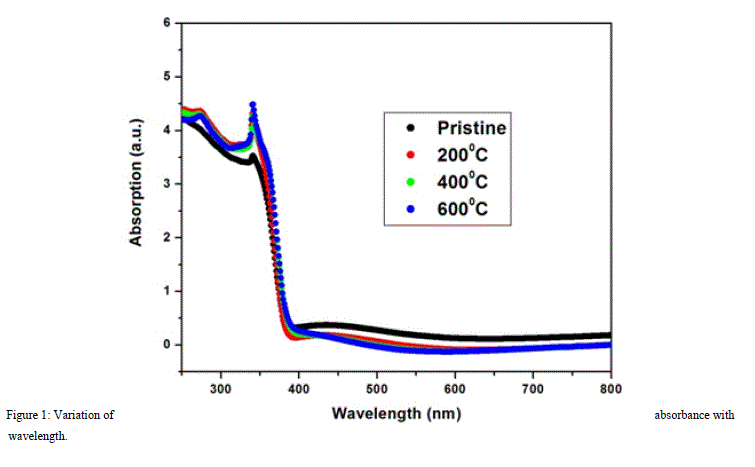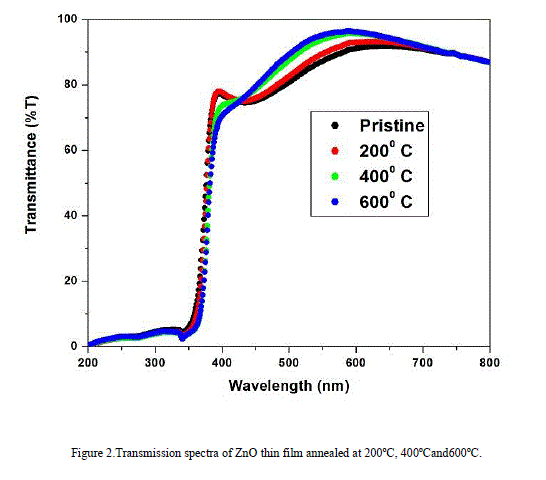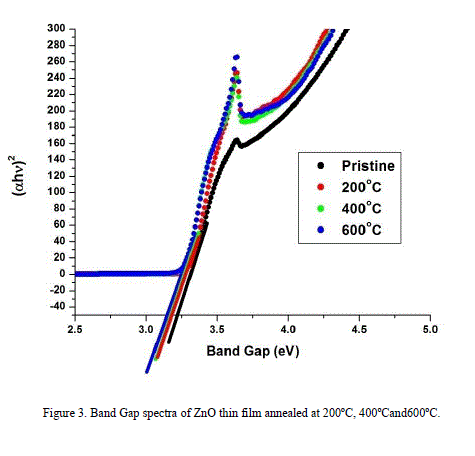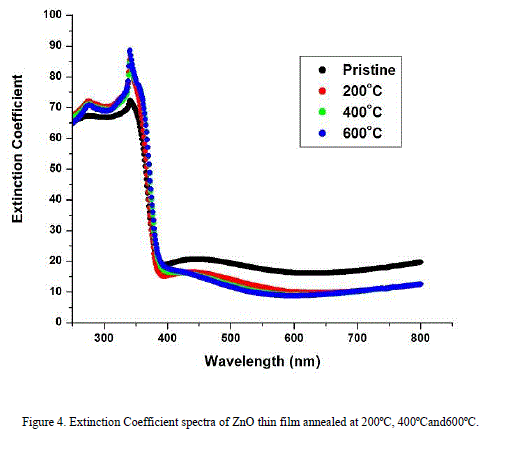ISSN ONLINE(2319-8753)PRINT(2347-6710)
ISSN ONLINE(2319-8753)PRINT(2347-6710)
Aman Jain1*, Mohit Johari3, Anshul Jain4, Praveen Kumar Pandey1, Rekha Agrawal2
|
| Related article at Pubmed, Scholar Google |
Visit for more related articles at International Journal of Innovative Research in Science, Engineering and Technology
In this work, we have synthesized ZnO thin film on quartz substrate by RF magnetron sputtering method. We annealed these films at three different temperatures of 200oC, 400oC and 600oC. The absorption spectra showed that the band gap of the deposited film was about 3.29 eV. So it confirmed that the film was of ZnO. As temperature increased the band gap of the film decreased. Transmittance spectra revealed that the transparency of the film increased with rise in temperature. Different optical constants such as refractive index, film thickness, band gap, transmittance, extinction coefficient and so on were investigated and compared at different temperatures. Ellipsometry revealed that the thickness of the film was 125 nm
Keywords |
| Thin film, sputtering, spectroscopy, ZnO. |
INTRODUCTION |
| ZnO is a unique semiconductor material with a wide band gap of about 3.3 eV. It has generated enormous research interest because of its stand out optical properties that are useful for nanolasers [1],piezoelectric nanogenerators [2], dye sensitized solar cells [3], gas sensors [4,5], photocatalyst [6,7], and so on. Many different deposition methods, such as metal organic chemical vapor deposition (MOCVD) [8], molecular beam epitaxy (MBE) [9], sputtering [10], chemical vapor deposition (CVD) [11, 12], pulsed laser deposition (PLD) [13, 14], spray pyrolysis [15] and the sol–gel technique [16], have been utilized for the growth of ZnO films on distinct substrates. Among these techniques, rf magnetron sputtering is considered to be the most common technique because of economic uniform film deposition. The fundamental optical property is refractive index as it gives the idea of electronic polarizability of ions and the local field inside the material [17]. The applications such as switches, modulator and filters, etc have refractive index as their key element for fabrication. In this context, ZnO thin films were prepared on quartz substrates by the RF magnetron sputtering method and annealed at 200oC, 400oC and 600oC, respectively. Optical constants of the films were explored using method suggested by R Swanepoel [18] and the effect of post-annealing on constants was also investigated. |
II. EXPERIMENTAL |
| The ZnO film was grown on quartz substrate by rf magnetron sputtering method. Prior to the deposition, the substrates were cleaned using acetone and the chamber was evacuated. Base pressure was maintained as 10-5 mbar. The distance between substrate to source was fixed at ~10 cm. After that High purity Ar gas was passed through the chamber. The Ar gas pressure was maintained at its optimum value of 10-2 mbar. The total pressure is stabilized at 0.015 mbar during the deposition process. Deposition was performed for two hours. Thermal annealing was performed at 200o, 400o and 600o C in air for an hour. The Zinc Oxide (ZnO) thin film samples were grown on quartz substrates. Absorption and transmittance spectra of the thin film deposited on quartz substrate were obtained by Hitachi 2900 UV spectrophotometer. |
III. RESULTS AND DISCUSSION |
| The optical characterization of ZnO samples were carried out by using dual beam spectrophotometer in the wavelength range from 200 – 800nm. Figure 1 shows the variation of absorption edge of ZnO thin film grown on quartz substrate with wavelength at different annealing temperatures. The absorption edge is obtained from the tauc plot method. [18], The band gap is determined by drawing tangents on these curves and it shows the decreases in the band gap on different annealing temperature as shown in figure 3. Figure 2 shows the transmittance spectra of the ZnO thin film deposited at different annealing temperature. Optical constant were calculated from transmittance and compare at different annealing temperature. It can be concluding from the spectra that the optical transmittance increases in the visible region while decreases in ultraviolet region as increase in temperature. |
| 3.1 OPTICAL CONSTANTS |
| The absorption coefficient can be determined from the transmittance spectra by the following relation [17] and calculated result is shown in figure 1. |
| Where T denotes the transmittance and d is thickness of film. From the absorption spectra it can be concluded that the absorption coefficient decreases with increases in wavelength and it can also be concluded that for a given wavelength, the absorption coefficient decreases in the ultraviolet region while increases in visible region. It is known that the absorption coefficient near the band edge shows an exponential dependence on photon energy: [17] |
| It is known that extinction coefficient is related to absorption coefficient by the following relation: |
| Where ïÿýïÿý ïÿýïÿý belong to extinction coefficient and it can be obtained from the absorption spectra of figure 1 over the entire wavelengths. Figure 4 shows the extinction coefficient variation over wavelength at three different annealing temperatures and it can be concluded from figure that there is an increment in the visible region and decrement in the ultraviolet region. The actual refractive index ïÿýïÿý ∗ ïÿýïÿý is written as |
| Where n is the refractive index and k is extinction coefficient. The refractive indices of ZnO film were investigated using interference method as suggested by R Swanepoel [18]. For a given wavelength, the refractive index, of pristine is 1.96, is calculated at different annealing temperature and it is found that the refractive index decreases as the annealing temperature increase as shown in table 1. |
IV. CONCLUSION |
| Absorption spectra were used to obtain extinction coefficient and transmittance spectra were used to calculate optical constants. The effect of annealing temperature on both the spectra was investigated. With increase in temperature the band gap and extinction coefficient show decrement in ultraviolet region and increment in visible region. Refractive spectra also show decrement on increasing temperature at a given wavelength. |
 |
 |
 |
 |
 |
References |
|